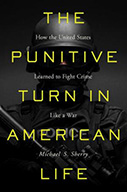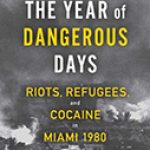The Punitive Turn In American Life: How The United States Learned To Fight Crime Like A War

Author: Michael S. Sherry
Publisher: University of North Carolina Press, 2020. 312 pages.
Reviewer: Anne-Marie Cusac ǀ January 2022
Michael S. Sherry’s The Punitive Turn in American Life: How the United States Learned to Fight Crime Like a War (University of North Carolina Press, 2020) opens with three shocking gun advertisements from the 2010s. “As Close as You Can Get without Enlisting,” reads one. Another compares U.S. war fields to the American home: “Iraq Afghanistan, Your Livingroom.” Those words accompany the image of a soldier and the reassurance: “built for them . . . built for you.”
The message of the ads, Sherry writes, is that “Americans at home could carry the same weapons of war that soldiers carried in battle. Many Americans believed, or at least were asked to imagine, that the line between war-fighting and crime-fighting had almost disappeared. This book is about how that happened.”
Sherry’s book adds to the body of work that shows American life shifting towards a culture of punishment from the 1960s and 1970s on. Authors who strongly influence the author include Michelle Alexander, Radley Balko, Katherine Beckett, Marie Gottschalk, Philip Jenkins, Peter B. Kraska, Joseph Margulies, Robert Perkinson, Keramet Reiter, Jonathan Simon, Heather Ann Thompson, and myself in Cruel and Unusual: The Culture of Punishment in America (Yale University Press). Sherry acknowledges and builds upon these authors’ studies, bringing insights from his past books on American militarism to the subject of American domestic punishment. The combination is a rich one.
The Punitive Turn in American Life adds important information to the conversation: 1) American punishment culture grew while the U.S. military shrank as a jobs option for young men and, as Sherry shrewdly observes, as a kind of crime control and containment for adolescent males. 2) The nation’s turn toward punitiveness did not rise from the grassroots, but instead originated in the language of our presidents, both Republican and Democrat.
“Dividing the story by presidencies” is “old-fashioned,” Sherry acknowledges. His book also shows how widespread and uncontrolled the process became, with punitive cultural changes occurring at the state and city level, in pop culture, and in private households. His look at the messiness of punishment culture echoes and credits previous scholarship. But his new emphasis on how U.S. Presidents helped turn the nation towards a militarized and punitive response to crime control “highlights what much scholarship neglects—the revealing role of presidents.”
For Sherry, the merging of war and crime control amounts to a social project that multiple presidents rhetorically signaled and encouraged, creating and feeding public fear. “A robust and persistent language of war on crime enmeshed the two spheres,” he writes. “The blurring of lines encountered little opposition, even though shrill presidential rhetoric often revealed it, because war and crime tapped similar fears and ambitions, overlapped institutionally, and served similar purposes. To move from a war on foreign foes to a war on domestic ones did not seem like a big shift.”
Punitiveness is a long bipartisan endeavor, as the author acknowledges. But, he says, several presidents pushed punishment culture forward in ways that have been overlooked. These figures include Lyndon Johnson, Gerald Ford, and George H.W. Bush. Johnson, in particular, he argues, should get credit as one of the originators of the effort to rescue the state’s legitimacy by directing military rhetoric and resources towards domestic crime.
From the early 20th century on, the U.S. military had served as a combination job-creation and crime-control program. But public criticism of the U.S. military intervention in Southeast Asia resulted in a crisis of legitimacy. While Sherry understands that “[n]o great historical shift has a single cause,” he sees the “Vietnam-era crisis in the militarized order that had dominated the nation and disciplined its youth since the late 1930s” as starting off the U.S. trend towards mass imprisonment and retributive cultural impulses. As the war-making order which had “harnessed industry, science, people, and propaganda” for decades started to crumble, “the state’s legitimacy came into question.”
Punitiveness enabled presidents to “reassert that legitimacy.” In doing so, they protected their own power, calmed the public, and transferred enormous resources (and people) to our justice system. As Sherry puts it, “[r]esources devoted to war and national security were partly redeployed to wage ‘war on crime,’ to use the term that became commonplace.”
What Sherry calls “redeployment” happened gradually and “was often halting, improvised, half intended.” He offers a birth date, and a creator: Lyndon Johnson: “When President Lyndon Johnson proclaimed on September 22, 1965, that ‘the policeman is the frontline soldier in our war against crime,’ the process was starting.”
Eisenhower and Kennedy made few comments about crime control. In contrast, Johnson said he would “banish” crime, a promise he couldn’t fulfill. Johnson seemed like a liberal, and “his crime-fighting efforts carried an aura of liberal social uplift and got lost in the sea of his many other initiatives and failures.” As a result, historians, and those who tell the tale of an emerging punitive culture, have mostly ignored Johnson. “But his administration did help start the punitive turn in response to the Vietnam-era disruption of a militarized order, thereby enmeshing it in the attitudes and institutions of war,” writes Sherry.
In addition to rhetoric, Johnson made policy changes. Project 100,000, for instance, drew young men, many of them African-American, into a training program for people the draft rejected. While Project 100,000 supplied hundreds of thousands of soldiers for the war in Vietnam, “the project was also underpinned by rationales about crime prevention.”
But the idea of military life as crime control began to fray. In the late 1960s, “it seemed that military service might instead provoke crime, in turn threatening the armed forces,” writes Sherry. The government began to focus not on those entering military service, but on the new Vietnam-era veterans, with a resulting turn toward a domestic war on crime.
The societal project was apparent in policing tools. “When empire retreats, it brings many of its toys home,” Sherry writes. In addition to things like armored police cars, “one of those toys was ‘the Curdler,’” a sound weapon used in Vietnam. An advertisement suggests its public use to “break up the slogan-shouting, chanting, and handclapping that unifies and hypnotizes a mob incited to riot.”
The author also sees the origin of institutions such as the Supermax prison and the return of extensive solitary confinement in the migration of defense tactics to domestic life. War, he says, “justified” their use at home. The power of the “war on crime” metaphor is evident in this justification.
But many Americans seemed to think the metaphor was more than rhetoric—that it was real. And as war on foreign lands leads to collateral damage, so too, the metaphor implies, will the war at home: “collateral damage to bystanders, danger to warriors as well as their targets, erosion of civil liberties and constitutional procedures, secrecy and deception, wasteful expenditures, abuse of enemies, distrust of those who resist the cause. Americans entered their war on crime having experienced such risks in World War II, Korea, and Vietnam, and in the threat of nuclear war. They were accustomed to such dangers, in part because they fell on others beyond their shores. Risks like these were so woven into the fabric of American’s historical experiences that few questioned their reappearance in a war on crime.”
American domestic punitiveness continued in varied iterations through ten presidents. Sherry writes that while Richard Nixon often takes the blame in histories of the war on crime, “[y]et he was neither a singular nor a steadfast figure in that regard.”
While American punishment culture surged during the 1970s, most accounts leave out President Gerald Ford’s leadership. “Scholars have dwelled on Vietnam, the subject Ford was trying to leave behind, not the one he was latching onto,” observes Sherry. “In these analyses, it is as if the punitive turn came from below—in the multitudes angry about crime, in the lower reaches of government—rather than from on high.”
The numbers reveal how extensively American society was changing. “With conscription ended and America’s war in Southeast Asia over, the armed forces shrank from over 3 million members in 1970 to 2.05 million in 1980 despite a growing youth population,” Sherry writes. “The share of men in service receded as women entered the military in large numbers. That decline corresponded roughly in scale and chronology with increases in the numbers of people imprisoned by or working for the criminal justice system. The population of sentenced prisoners grew by over 100,000 during that period, and arrests for violent crimes leapt 65 percent after 1970, reaching 475,160 in 1980. At the same time, employment in criminal justice rose sharply, by more than one third, between 1971 and 1979, reaching 1,275,031 that year.”
Ronald Reagan and George H.W. Bush fostered public personas that belied their language and actions. Reagan, Sherry writes, was often seen as “genial,” and Bush as “moderate and reasonable.” But historians “have paid less attention to how harsh, sometimes ugly, and war-saturated their rhetoric and policies on crime were.” Sherry cites some revealing quotes, such as Reagan’s claim that “[b]y 1980, illegal drugs were every bit as much of a threat to the United States as enemy planes and missiles.”
Sherry critiques Clinton’s disingenuous rhetoric on the 1994 crime bill, which, Clinton claimed, “means more police, more punishment, and more prevention.” But “prevention” had a new meaning, Sherry explains, “that is, more capacity for the carceral state.” By that decade the meaning of “prevention” had expanded from housing, food, and education programs to include “the punitive option.” Indeed, the Congressional Black Caucus, which voted for the 1994 crime bill, had hoped it would contain crime prevention in the form of societal programs. When the bill didn’t, most (with the significant exception of Jesse Jackson) voted for it.
Under George W. Bush, the 9/11 attacks led to the desire on both sides of the conflict to demean one’s enemies. Sherry notes that Bush’s desire frequently moved outside a “language of crime-fighting” to carry an “echo of lynching” that “often featured wishes for the degradation of the enemy’s body.”
A vigilante-tinged desire for degraded bodies resulted in torture at Abu Ghraib, but it strongly echoed homegrown U.S. treatment of domestic prisoners. Citing my own work on the export of American punishment practices to Iraq, where they found expression in the torture at Abu Ghraib, he notes how difficult it was for an American public to face up to physical mistreatment in its own prisons that had traveled overseas. “The posture of surprise about Abu Ghraib that Cusac tried to counter had shielded observers from thinking about what also happened at home. Americans could be surprised by torture abroad only if they claimed ignorance about torture in their own country. That stance made brutality toward prisoners overseas seem rogue, bizarre, and exceptional, thus insulating most Americans from acknowledging how far-reaching the practice was in America.” Carter and Obama offered pauses in the expansion of punitive culture, but their disinclination did little to turn back the decades-long push toward vengeance. Yet, during Obama’s tenure, the rise of mass activism encouraged reform. The activism happened in part because there was “more to resist,” Sherry writes. “Yet the punitive turn churned on, invigorated in some arenas even as it was trimmed in others, so that additions canceled out subtractions.” The punitive impulse, started by Johnson and furthered by many others, had become central to American culture.
About the future, Sherry like many who write on American punishment, is not sanguine. He acknowledges Marie Gottschalk’s work on the intricate system of punitive laws, so embedded “they had become ‘one of those causal or shaping forces’” (as Gottschalk writes, citing Craig Haney), and almost impossible to unweave from other cultural strands. Reforms can make only small changes to a justice system that has expanded for decades.
Yet small changes add up, suggests Sherry, in the measured hopefulness of his penultimate chapter. “No such ingrained system would be dismantled, but it might be whittled down through all sorts of measures. With so many attacking the system from so many vantage points, by 2020, it seemed possible to chip away at it seriously. If not death by a thousand cuts, at least serious injury by hundreds.”
“Serious injury” would change American society. Such measured hope is as realistic as hope can get after nearly sixty years of a punishment culture. And Sherry chastens even this hope with his epilogue, which points out how President Donald Trump chaotically tapped “animal spirits” with “fickle and explosive” vengeful talk, extended militarized crime response to border immigration operations, and carried out a “motley collection of modest” sentencing and prison reforms with the First Step Act in 2018.
For those who seek a less-punitive future, Sherry’s book offers an important education on the dangers and cultural powers our executives wield with their metaphors.
Anne-Marie Cusac is the author of Cruel and Unusual: The Culture of Punishment in America (Yale University Press, 2009) and an Associate Dean of the College of Arts and Sciences at Roosevelt University in Chicago, where she is also a Professor of Journalism.


